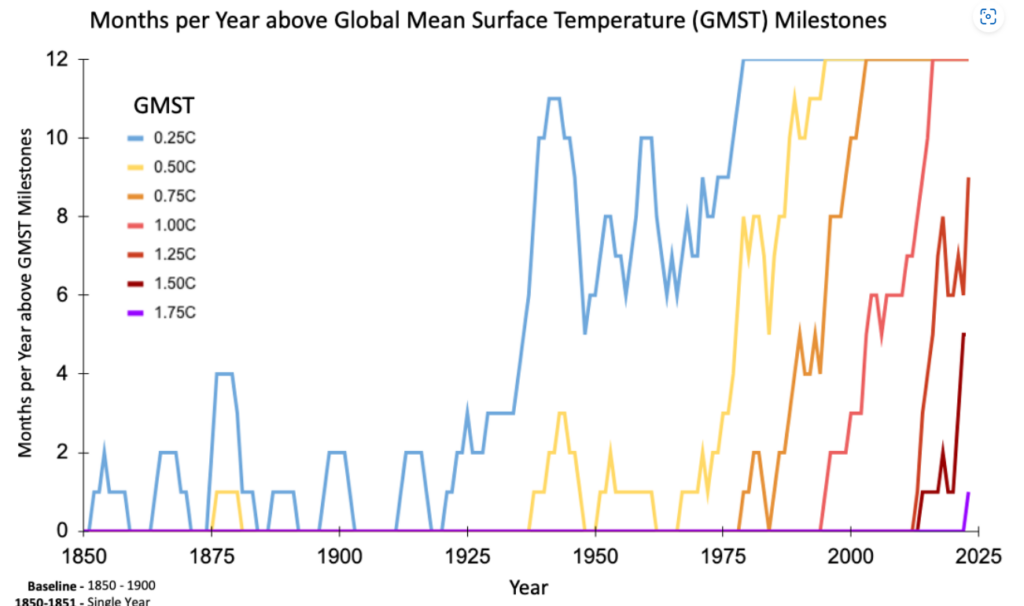Dag Lindgren, sista ändring 240618
Här visas med nya kriterier på svenska att det globala temperaturklimatet ändrats i snabbt ökande takt, långt snabbare än vad den etablerade klimatforskningen ger intryck av Ett komplement till de många utmärkta klimatanalyser som utförts och till IPCCs gedigna arbete, som dock har eftersläpning och kanske är för försiktigt.
Studien har publicerats i Ökad variation i temperatur har betydelse (tidningenglobal.se)
Utgångspunkten, inspirationen, data och några engelska termer kommer från https://parisagreementtemperatureindex.com/ av Chris Priest, Brighton. Jag rekommenderar webben för djupare information om global uppvärmning. Jag tycker författaren gjort ett utmärkt nyskapande arbete. Utgångspunkten är Global Mean Surface Temperature (GMST). Milstolpar (Milestones) för temperaturökningen sätts till 0.50, 1.00, 1.25, 1.50, 1.75 och 2.00 grader C över förindustriell tid. Den förindustriella tiden sätts till genomsnittet 1850-1900, eftersom det inte finns pålitliga tidigare uppskattningar, men uppvärmningen är nog något större. Varje dags globala temperatur jämfört med förindustriell tid (anomali) registreras och utgör de data som analysen nedan bygger på.
Analysen resulterar i 4 tabeller över temperaturökningar över tiden: Första dagen en temperatur överskrids, första månaden, första året, när 100 dagar överskridit.
Tabell 1. Tidpunkt när en dagstemperatur uppnås första gången och hur länge det var sedan en lägre milstolpe först registrerades. https://parisagreementtemperatureindex.com/1000-day-climate-graphic-design/
| GMST Milstolpe | Första dag temp>Milstolpe | År efter att tidigare Milstolpe passerades |
| 0.75 C | Feb 1941 | |
| 1.00 C | Jan 1958 | 19 |
| 1.25 C | Feb 1995 | 37 |
| 1.50 C | Dec 2015 | 20 |
| 1.75 C | Feb 2016 | 1 |
| 2.00 C | Nov 2023 | 7 |
Det tog 8 år att gå från varmaste dag 1.5 grader över förindustriell tid till att varmaste dag 2 grader över, men 57 år från att varmaste dag var 1 grad över tills den var 1.5 grader över. Jättestor skillnad mellan samma temperaturintervall nu och förut!
Tabell 2. Tidpunkt när första månaden över en Milstolpe inträffar och hur länge sedan ett lägre värde passerades °C Milestones – From First Appearance to Permanence – Paris Agreement Temperature Index
| Milstolpe | År första månaden >Milstolpe | År efter att tidigare Milstolpe passerades |
| 0.75 | 1979 | |
| 1.00 | 1997 | 18 |
| 1.25 | 2014 | 17 |
| 1.50 | 2015 | 1 |
| 1.75 | 2023 | 8 |
| 2.00 | 20? |
Det tog 9 år att högsta månadsvärdet höjdes från 1.25 till 1.75 grader. Det tog 35 år för högsta månadsvärdet att öka lika mycket från 0.75 till 1.25 grader över förindustriell. Jättestor skillnad för samma temperaturökning.
Tabell 3. Första året en milstolpe passeras och hur många år det tog sedan föregående milstolpe passerades 1000 Days above 1.5C before Trend passes 1.5C? (parisagreementtemperatureindex.com)
| GMST Milstolpe | Första året temp>Milstolpe | År sedan förra milstolpen passerades |
| 0.50 C | 1984 | |
| 0.75 C | 2000 | 16 |
| 1.00 C | 2012 | 12 |
| 1.25 C | 2020 | 8 |
| 1.50 | 20? |
Det tar dubbelt så lång tid för årstemperaturen att stiga från 0.50 grader över förindustriell till 0.75 grader som det tar att stiga från 1.00 grader till 1.25 grader.
Tabell 4. År när 100 dagar legat över Milstolpe. Data från 1000 Days above 1.5C before Trend passes 1.5C? (parisagreementtemperatureindex.com)
| Milstolpe | Approximativt år 100 dagar > milstolpe | År sedan tidigare Milstolpe passerades |
| 0.50 | 1944 | |
| 0.75 | 1980 | 36 |
| 1.00 | 1998 | 18 |
| 1.25 | 2010 | 12 |
| 1.50 | 2017 | 7 |
| 1.75 | 2024 | 7 |
| 2.00 | 20?? |
Det tog 30 år för de 100 varmaste dagarna att stiga från 0.75 grader till 1.25 grader. Men bara 14 år från att de låg över 1.25 grader till att de låg över 1.75 grader. Fördubblad ökningstakt!
Det går att omvandla data från Tabell 4 till uppvärmning per år som en funktion av året som gjorts i Tabell 5 nedan.
Tabell 5 beräkning av global temperaturökning per år

2024 för man naturligt eftersom de två föregående värdena är samma. Då får man nedanstående Figur.

Få är medvetna om hur snabbt uppvärmningen nu går och hur kraftigt uppvärmningens takt har ökat, Jag trodde definitivt inte detta innan jag började grubbla och tänka över det i slutet av 2023!
Vad beror effekten på om inte enbart accelerad uppvärmning? Själv tror jag en ökad variation i temperatur har betydelse, men det är inte speglat i en ökande variation i årsmedelvärdena. Det kanske är någon sorts växelspel med geografisk variation, dagligt variationsmönster, häftigare variationer i luftens och havens strömmar och säsongsvariation som döljer en lokalt ökande temperaturvariation. Att det blir varmare innebär att större energier och energiöverföringar är inblandade och det borde också öka variationerna. Det finns mycket att grubbla över här och de professionella klimatologerna verkar inte tänka i tillräckligt vida banor..

